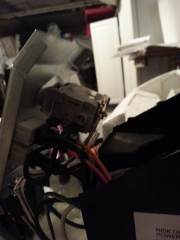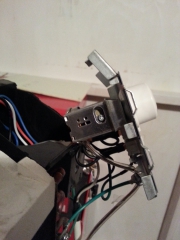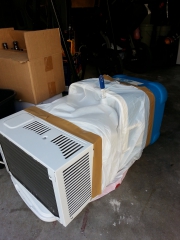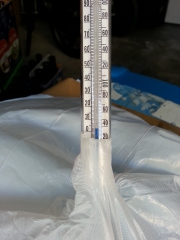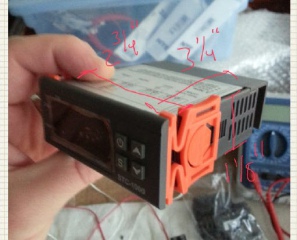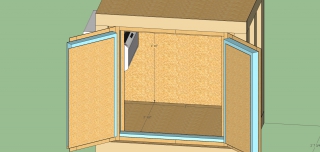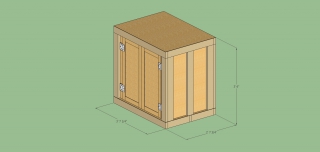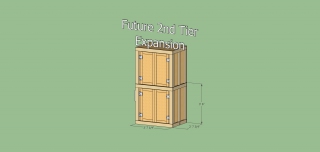After my last batch of beer, Baby-T Double Trouble Belgium Dubble, came up short on the alcohol content I’ve decided that my problem is due to my fermentation temperatures…and possibly my aeration. I was also having a hard time using my wort chiller since the hose water that I’ve circulated through it wasn’t too cold. So I’m stepping it up a notch.
I got a drill off of Craiglist for about $20 and a drill water pump from Home Depot. Next time I chill the wort I’ll be circulating iced water from a cooler through the chiller which should bring the temps down right away. I also bought a large drill-attached paint mixer to help aerate the wort after it is chilled. One thing I’m slightly hesitant on is that while I plan to sanitize the mixer, I don’t know if I’ll run into any problems since it isn’t a food grade mixer. I guess I’ll learn soon enough.
Now to the main issue, temperature control. For all my batches to date I’ve simply left the beer to ferment in the back of the garage. The temperature usually stays around 60 degrees, but on really hot days it will rise to 70 and on consecutive cold days it will drop to low 50s. For my last batch I started fermenting right as a cold spell hit which I’m pretty sure caused the yeast to not ferment all the sugars. After a lot of reading the only way I’m going to get around the problem is to get some temperature regulation through a fermentation chamber.
I did a lot of reading in the http://www.homebrewtalk.com forums to get ideas of how to go about building a fermentation chamber. I think there are basically three types of chambers, those that use ice, those that use a fridge components, and those that use air conditioners. The ice ones are simple (1,), but if you ask me annoying to maintain. The fridge styles have many variations. Some work as is, some take some cutting of the interior to make room for a carboy (1,2,), some look to extend the fridges dimensions with some type of add on (1,), and others strip out the cooling component and then use a custom box (1,). For the AC styles they are pretty much the same, take an AC unit and build a custom box (examples below).
Our garage is already packed with stuff, so the custom box idea was the most attractive to me. The next part was to decide fridge or AC which is the single most expensive part. I simply trolled Craiglist for a while until I found something cheap. For me it ended up being a $30 Haier 5000BTU AC unit (HWF05XCK-1) which I learned was purchased from Target the year prior when we were having a huge summer heat wave and the person selling it was moving to Saudi Arabia. I joked with the person that they probably should have taken the unit with them, but assured them that I’d put it to good use. Anyways, just as noted in the Racer X design to override the temperature cutoff on the AC unit a simple loosening of the screw behind the temperature knob will do the trick.
AC Unit with my measurements (click the picture for a larger view)
The screw is here (hard to see)
This is the other side, do not mess with this screw
With the screw loosening I rigged up a quick test to see that I did things just right
The temperature is down to 36 degrees F!
With the AC unit and the idea to make a custom box, I needed to sort out the temperature controller. I very very long forum about an aquarium temperature controller that can be bought on ebay seemed like the ticket for me. This controller usually can be bought for $15-$20 and I got my first one for $15.50 and the second for $18.25 (I’ll explain later…which if I knew how to do ebay better should have been $17, but I’ve wasted $1.25 on worse before). Here is a quick look at one with my measurements marked up on it:
Now off to design the chamber. My design was strongly influenced one the 2 Tier, 2 Zone fermentation chamber (Racer X). It is a really nice build and as it turns out I ended up with the exact same AC unit as his (even though they are listed as different brands). This chamber is really nice as it allows for one cooling unit and two temperature controllers to create the two zones. There are a few others with similar ideas that I looked at too (1, 2, )
I decided that while I really like the 2 zone idea I don’t need that right now, but that I’d make my design with a future expansion in mind. I wanted to make sure that this could hold a keg plus kegging gear, 3 soda kegs plus gear, 4 carboys, or 4 5G buckets, or 2 buckets and all of my other brewing gear so that I’m not scattered all over the garage. With this in mind I settled on an interior dimension of 34″ x 36″ x 24.5″ (height, width, depth when looking at the front).
Additionally, here are a few design notes that I took from all my forum reading
- Use the best (i.e. highest R-rated) rigid foam. A look at Home Depot says there is a 2″ foam with an R-10 value that is moisture resistant
- Seal all the edges to avoid air leaks
- A 2×4 is not 2″ by 4″. It is really 1.5″ x 3.5″
- On the interior paint the inside with a mildew resistant paint and caulk the edges.
- I want easy access to the interior. No top doors so that I can leave things on the top.
- 20A requires 12 guage wire. 10A requires 18 gauge.
I messed around for a bit trying to figure out how I would go about designing this. When I did my bar a few (many) years back, which I’ll post about some other time, I did it all in excel where each cell represented 0.25″. that worked out well, because a quarter inch was the smallest thickness of wood that I used. For this design I plan to use 1/8″ plywood and excel just won’t work as there are too many cells needed. I ended up doing the design the simple way, engineering paper, a ruler, and a pencil. For the most part I had each square represent 2″. The 1/8″ is hard to draw clearly, but I made it work. I won’t go into all the effort spent making the design, but below are the drawing for the chamber. As in the Racer X design, the doors are the hardest part. I decided to have two doors that swing open from the sides. If you look carefully at the design, I’ve staggered the plywood and foam cutting one inch from the sides, the top, and between the doors. With this staggered approach the doors actually don’t come together in the middle, but I have a door cover that makes it appear as if it does. I need to sort out how to add the weather stripping, but for now I’m planning on just slicing a bit of foam away from the edges for it. The other thing that I know I have left off is the hole for the AC unit. I’m planning to simply cut as needed and figure the support required to keep it at the proper angle (note the AC unit isn’t supposed to be level.).
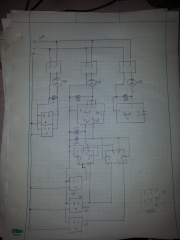
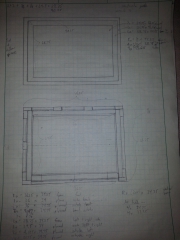
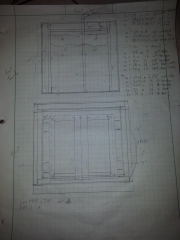
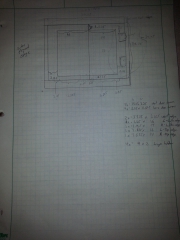
Once I had the design drafted I determined how much wood and foam I’d need. I was able to get it down to 13 2x4s, 2 foam sheets, and 3 plywood sheets.
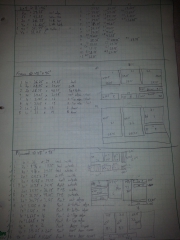
The next thing I needed to sort out was how I was going to wire the chamber up. The temperature controller forum had a lot of good ideas. I decided that I’d have one outlet for the hot, one for the cold, and two for either hot or cold. I also wanted to be able to turn the outlets on and off without unplugging them so I needed a switch. I added some indicator lights. I added another switch for another outlet that I can keep on the outside of the chamber. I’m going to wire up the second temperature controller to just be a simple thermometer since the temperature probe on the beer will be slightly different due to the exothermic reaction of the yeast fermenting beer. I plan to have this whole circuit plugged into a 20A circuit, but the temp probes are only rated for 10A so I’ve added a 10A fuse to each circuit. 10A will be plenty as the AC unit is only ~4A and I don’t intend to pull a full 20A at once. As I mentioned above I got the temperature controllers off of ebay. I found a really good deal on switches, relays and indicators from allelectronics.com and now just need to get the outlets, wire, and boxes.

So that is all the planning which I did before my birthday. In hopes of getting some home depot gift cards I’ve waited a while to actually get going on this. In my free time which is very limited now that we have baby Chase on our hands I modeled the design in Sketchup. This took me a bit of learning to be effective at this, but after a short while I got the hang of it and was able to put together the plans. Good thing too as I learned a few things that caused me to make some adjustments in the design.
Click the link to see the animated sketchup of the design
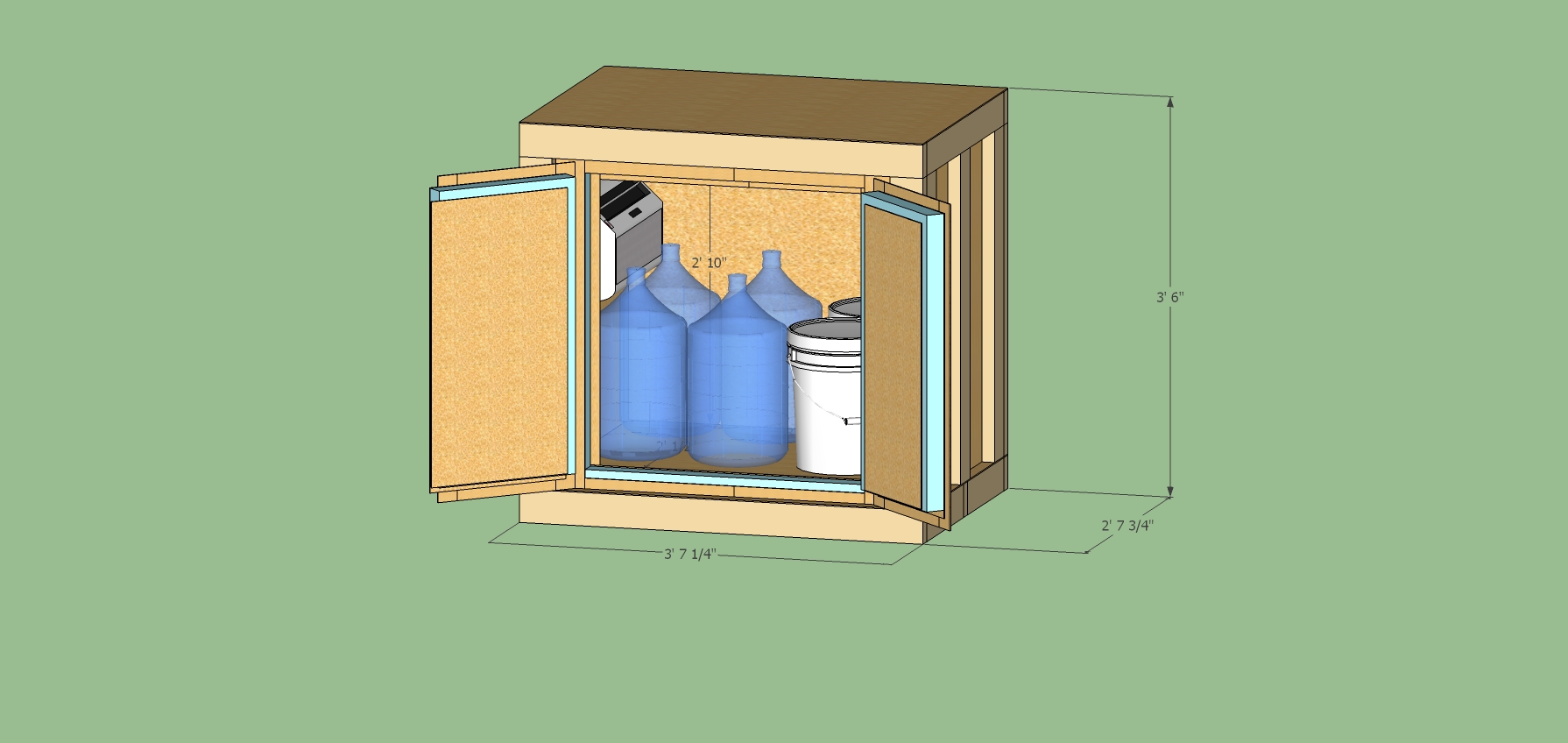
Here are a few other views of the model
Doors closed
Doors open with no objects
with the future expansion
In case anybody is interested here is the Single Ferm Chamber Sketchup File.
Well that is all for now and I’ll share the final product when it is done.

Dilbert



























